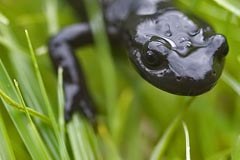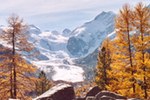News
What do the Julian Alps/Sl and the mountain La Salève/F have in common?
May 26, 2010
/
alpMedia
Both are examples of protected areas in the alpine bio-geographical region and are presented in the new publication of the European Commission "Natura 2000 - Protection of Biodiversity in Europe". A double page spread shows readers which animal and plant species are particularly in need of protection, how the areas are protected and what their condition in terms of preservation is.

Image caption:
Lanza's Alpine Salamander is considered to be endangered, and has been included in the European red list. © Fotobibliothek ALPARC und alpine Schutzgebiete / http://richardg.blogs.com/
The concise presentation also contains travel tips and many photos and maps. In addition the publication "Natura 2000 in the Alpine Region" gives an overview of high mountain areas in the EU: the Alps, the Pyrenees, the Carpathians, the Apennines and the Scandinavian Alps.
The red lists are an important tool for realizing the flora-fauna-habitat directives of the EU. The first European red lists - for amphibians, reptiles, butterflies, dragonflies and wood-boring beetles - have been published. They cover all species of a specific group of animals, not only those protected by law. The red lists therefore present the overall situation of a group of animals. Next year, the red lists for invertebrates, freshwater fish and vascular plants are to be published.
Publication: Sundseth, K. (2008): Natura 2000 - Protecting Europe's Biodiversity, Luxemburg, ISBN 978-92-79-08308-2.
The other publications can be downloaded under http://ec.europa.eu/environment/nature/info/pubs (de/fr/it/sl), http://ec.europa.eu/environment/nature/conservation (en)
The red lists are an important tool for realizing the flora-fauna-habitat directives of the EU. The first European red lists - for amphibians, reptiles, butterflies, dragonflies and wood-boring beetles - have been published. They cover all species of a specific group of animals, not only those protected by law. The red lists therefore present the overall situation of a group of animals. Next year, the red lists for invertebrates, freshwater fish and vascular plants are to be published.
Publication: Sundseth, K. (2008): Natura 2000 - Protecting Europe's Biodiversity, Luxemburg, ISBN 978-92-79-08308-2.
The other publications can be downloaded under http://ec.europa.eu/environment/nature/info/pubs (de/fr/it/sl), http://ec.europa.eu/environment/nature/conservation (en)


